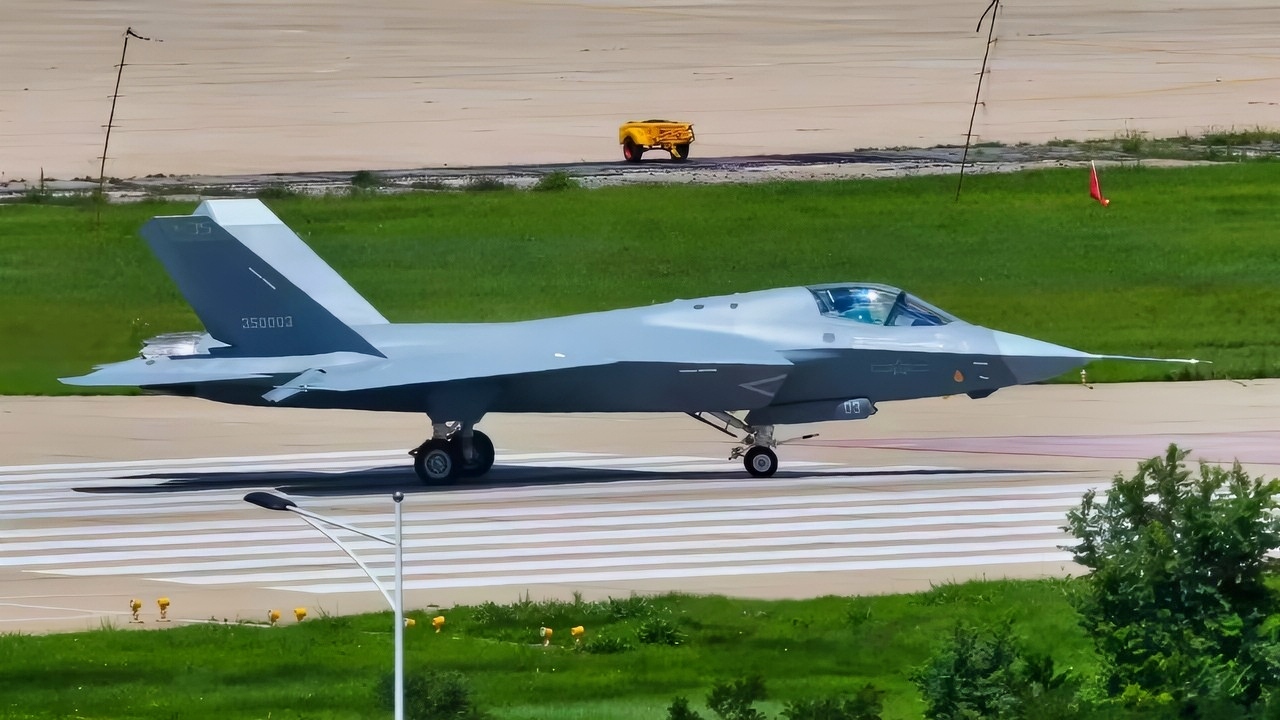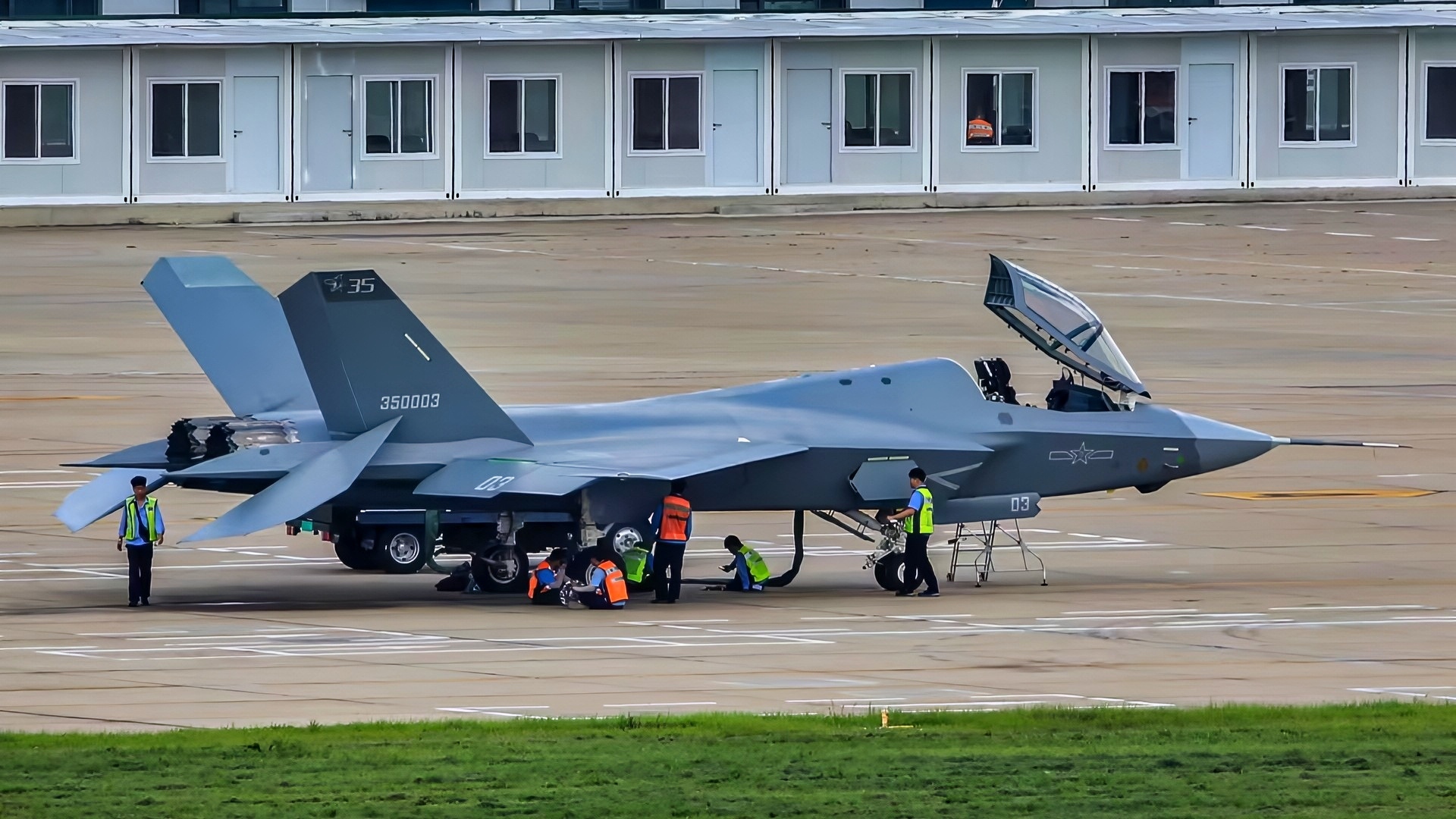Key Points and Summary – China’s J-35 traces a straight line from the export-minded FC-31 prototype to a CATOBAR-ready, carrier-borne stealth fighter for the Type 003 Fujian.
-Designed with folding wings and a catapult launch bar, the twin-engine jet is now reported in low-rate production and moving through carrier integration, a sharp break from the interim J-15/Su-33 lineage.

J-35A Fighter Chinese Military. Image Credit: Creative Commons.

J-35 Fighter X Screenshot. Image Credit: X Screen Capture.

J-35 Stealth Fighter from China. Image Credit: Creative Commons.
-If Beijing fields 80 airframes by the early 2030s, the PLAN gains longer-range, lower-observable airpower at sea—projecting force, screening fleets, and complicating Western planning in the first island chain.
-Beyond tactics, J-35 signals an industrial pivot: from copying to iterating, with potential export pull and faster upgrade cycles.
How Beijing Built Its Stealth Carrier Jet, the J-35
The J-35 naval variant is the centerpiece of China’s push to field a true fifth-generation carrier-borne stealth fighter.
Derived from the export-oriented FC-31 program, the carrier variant is now being customized and tailored for operations with the Type 003 Fujian-class supercarrier and may soon provide the People’s Liberation Army Navy (PLAN) with capabilities that were previously only achievable by the West.
Its origin story reveals how Beijing has moved from relying on upgraded foreign derivatives – largely Russian planes – to creating its own indigenous naval aircraft that can almost compete with the West’s most advanced aircraft.
This went from a private venture to a naval combat asset that proves China is capable of doing what needs to be done to become a full peer adversary to the United States in terms of military aviation.
China’s Carrier Ambitions from the J-15 to Now
The story begins with the Liaoning, commissioned in 2012, and the Shandong, commissioned in 2019. Both are STOBAR (ski-jump) launch platforms with limited fighter options, and with these carriers, China primarily relied on the Shenyang J-15, a derivative of Russia’s Su-33 design.

Su-33 Flanker from Russia. Image Credit: Creative Commons.

Sukhoi Su-33 launching from the Admiral Kuznetsov.

Sukhoi Su-33 launching from the Admiral Kuznetsov.
However, both of the platforms had compromises.
They constrained payload, range, and stealth. Recognizing these limits, China began investing in a CATOBAR-capable carrier, the Type 003, and a matching stealth fighter that would operate from it.
In short, Beijing knew that to compete with the West, its naval and aviation ambitions needed to match—and, with these new developments, China ensured it could transition away from short-range, land-sea operations toward true power projection at sea.
So, what was the J-15?
In simple terms, it was an interim solution for carrier-based fighters. The J-15 program began around 2006 after China acquired a Su-33 prototype from Ukraine and reverse-engineered it. The J-15 entered service circa 2013 and has long been labeled a fourth- or 4.5-generation aircraft.
At the same time, from around 2012, the FC-31 (also known as the J-31) was born. It is a twin-engine stealth demonstrator that was first flown in October 2012 and initially designed for export.
The FC-31 served as the technological basis for China’s next-generation domestic fighters, and analysts later linked the navalized version of the FC-31 to the J-35 program.
By late 2021, the carrier variant of the FC-31 (the J-35) made its maiden flight, featuring modifications for carrier operations, including folding wings and a catapult launch bar.
That story and process demonstrate a clear shift in China’s strategy, as well as an advancement in the country’s industrial capacity and capabilities. Beijing went from importing and adapting foreign designs to developing its own export stealth demonstrator, and it almost matches American capabilities.
The J-35 naval variant has also undergone rapid development since then.
By 2021, images and reports showed the prototype with catapult-launch modifications, meaning it could operate on China’s newest carriers.
This was a new, more flexible design intended to bring China firmly into the future. By mid-2025, photographs indicated that the aircraft was finally in low-rate production, featuring PLAN markings.
The J-35 is expected to become the primary carrier-borne stealth fighter on the Fujian, using electromagnetic catapults to launch heavier loads and thus outperform earlier ski-jump launches. The platform is understood to be undergoing carrier integration trials.
The J-35 Matters
There are many reasons the J-35 matters to China and the rest of the world. This is a significant advancement in Chinese naval aviation capabilities, giving its military a stealthy carrier-based fighter for the first time.
With the J-35, China can project airpower from the sea with a design comparable, at least in theory and concept, to the American F-35 family. The J-35, operating from a carrier, will allow China to threaten adversary carrier task forces from great distances while supporting its deterrence in the East/South China Seas.
But from an industrial perspective, this is very interesting, too.
The J-35 program reflects China’s maturation in this space. Yes, it’s no longer dependent on foreign designs.
That’s a huge step. But perhaps more interesting —and remarkable —is that China is now going above and beyond the countries that used to supply its aircraft designs.
China is rapidly becoming the United States’ most competent adversary in this space.
That makes Beijing a bigger threat, but it also means China’s allies could soon begin to benefit from export designs that are quickly catching up to American capabilities, too.
In a region of rising tension—the Taiwan Strait, the South China Sea, and the first island chain— the J-35 will allow China greater flexibility to base airborne assets at sea, arm its allies, and complicate Western planning.
As many as 80 J-35s could be fielded by the early 2030s, which is enough to equip two Fujian-class carriers and replace aging J-15s across the fleet.
About the Author:
Jack Buckby is a British author, counter-extremism researcher, and journalist based in New York. Reporting on the U.K., Europe, and the U.S., he works to analyze and understand left-wing and right-wing radicalization, and reports on Western governments’ approaches to the pressing issues of today. His books and research papers explore these themes and propose pragmatic solutions to our increasingly polarized society. His latest book is The Truth Teller: RFK Jr. and the Case for a Post-Partisan Presidency.
More Military
Europe’s New 6th Generation GCAP Stealth Fighter Looks Unaffordable
49 ‘New’ M1A1 Abrams Tanks Were Sent to Ukraine by Australia and America Doesn’t Approve
The U.S. Marine Corps Is Facing a Tough Drone Reality
‘300 Percent More Lethal’: The U.S. Army Is Putting China and Russia on Notice










